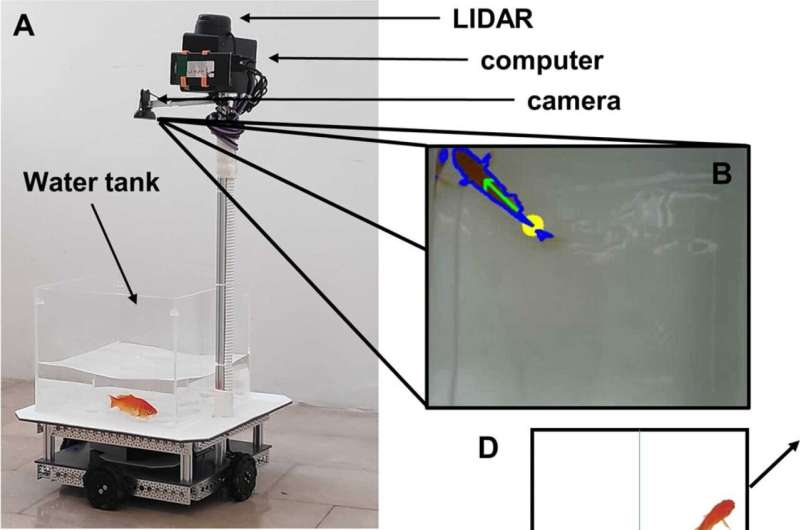The fish operated vehicle. A. The fish operated vehicle is composed of a chassis with 4 electric motors equipped with omni wheels, and a camera together with a LIDAR to collect data on fish position and vehicle position in space, respectively. B. View of a fish from the camera: fish contour (blue), tail (yellow), direction vector (green) are automatically extracted from the image and fed to the control system of the wheels. C. The fish operated robot and arena, bird's eye view. The enclosure was created by the room walls and a curtain where the target was placed. D. Instance of fish quadrant location and direction correlating; as a result, the vehicle moves in the direction of the arrow. E. Fish location is far from the water tank wall; the vehicle motors do not generate movement. Credit: Behavioural Brain Research (2021). DOI: 10.1016/j.bbr.2021.113711
A team of researchers at Ben-Gurion University of the Negev has taught goldfish to pilot a tiny land vehicle. In their paper published in the journal Behavioral Brain Research the group describes the vehicle, how the fish were taught to use it and the navigational skills they displayed.
Prior research has shown that some animals have surprising skills—rats, for example, are not only capable of driving around in little rat cars, but can use them to get to a desired destination. In this new effort, the researchers found that goldfish have similar abilities.
The work by the team in Israel was a means to learn more about navigational skills in general. More specifically, they wanted to know if goldfish, like other creatures, are able to use domain-transfer methodology by which a creature applies one set of navigational skills to multiple environments. To find out, they built a fish-operated vehicle (FOV): a small fish tank mounted on a wheeled frame. The team also fitted the FOV with a pole-mounted camera, processor and a LIDAR system pointed down at the fish in the tank. The LIDAR and camera were used to determine where the fish was in its tank and its orientation, and where the tank was in relation to its environment. The processor used the data to decide which direction to move the FOV. When a test fish pointed itself at a target, the FOV would drive in that direction.
I am excited to share a new study led by Shachar Givon & @MatanSamina w/ Ohad Ben Shahar: Goldfish can learn to navigate a small robotic vehicle on land. We trained goldfish to drive a wheeled platform that reacts to the fish's movement (https://t.co/ZR59Hu9sib). pic.twitter.com/J5BkuGlZ34
— Ronen Segev (@ronen_segev) January 3, 2022
The researchers then allowed the fish to meander around in their little fish tanks in random fashion and to note the impact of their actions on the movement of the FOV. Next, they added targets for the fish—if they reached one of them, the fish would get an immediate food reward. Over time, the researchers found that the fish came to understand that their actions could impact the movement of the FOV in desired ways, leading them to a tasty reward. Next, the team changed the environment—the fish drove their little FOV around both indoor and outdoor arenas and with changing targets and obstacles. They found the fish had no problems adapting; they drove straight for their reward, demonstrating their ability to use the FOV to navigate to desired locations.
More information: Shachar Givon et al, From fish out of water to new insights on navigation mechanisms in animals, Behavioural Brain Research (2021). DOI: 10.1016/j.bbr.2021.113711
Journal information: Behavioural Brain Research
© 2022 Science X Network
























